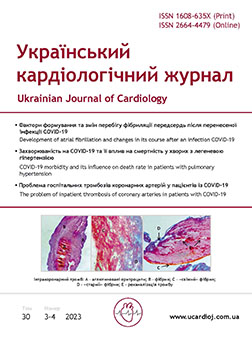Development of atrial fibrillation and changes in its course after an infection COVID-19 depending on age, gender and anthropometric characteristics
Main Article Content
Abstract
The aim – to analyze the probability of the development of atrial fibrillation (AF) «de novo», as well as to determine the course of an already existing rhythm disturbance after a transferred infection of COVID-19 in patients with different age, gender and anthropometric characteristics.
Materials and methods. The study involved 116 patients with AF who were hospitalized in the department of clinical arrhythmology and electrophysiology from September 20.09.2020 to 21.12.2021 and had a history of coronavirus infection (CI). The 1st group – 36 people (31 %) in whom AF occurred after CI. The 2nd group – 25 patients in whom the form of AF has changed. The 3rd group – 55 patients in whom the form of AF did not change. In the 3rd group, two subgroups were formed: 3A – 35 patients in whom, although the form of AF did not change, the frequency or duration of arrhythmia paroxysms increased, and 3B – 20 patients without significant changes in the course of AF. As the first control group (C1), 49 patients with AF without a history of CI were examined. The second control group (C2) was formed by 22 patients after a CI in whom AF did not develop.
Results and discussion. C1 patients were older than C2 patients by 10.4 years, p<0.0001. Individuals of groups 2 and 3 were probably older by an average of 2.5 years than the patients of the first control group. Group 2 patients were statistically significantly older (by 3.6 years) than group 3 patients. A large difference in age (by 12.9 years, p<0.001) of patients of the 1st group compared to the second control group was noted. That is, the older age of the patients was the cause of both «de novo» AF after a CI and the worsening of the course of this arrhythmia in those patients who had it before the infection of COVID-19.
There were more women than men in the 2nd and 3rd compared to each other (where the ratio was 1.16:1.0) and compared to the control group (where the ratio was 0.44:1.0). Among the patients of the 3rd group, the frequency and duration of paroxysms increased in subgroup 3A, where there were statistically more women than in subgroup 3B and in the first control group. In addition, there were significantly more women than men in subgroup 3A (ratio 1.5:1.0, p<0.0001), which is a significant difference in the ratio of female to male patients in patients of subgroup 3B, where their ratio was 1.0:1.0. Therefore, female gender is a risk factor for the deterioration of the course of AF after infection with COVID-19.
Excess body weight was found in 60 % of cases in patients who underwent CI and had AF. Patients of the 1st group, in contrast to C2, more often had excess body weight (BMI from 25 kg/m2 to 29 kg/m2). In subgroup 3A, unlike subgroup 3B, the average value of BMI was higher by 9 %. Excess weight contributes to the appearance of AF after CI and worsens the course of this arrhythmia.
Conclusions. Excess body weight or obesity was found in 60 % of cases – i.e. in the vast majority of OG patients who underwent CI and had AF. The older age of patients (mostly over 60 years old), excess body weight and female gender in patients after a COVID-19 infection were risk factors for the occurrence of «de novo» AF and worsened the course of this already existing rhythm disorder.
Article Details
Keywords:
References
Шумаков ОВ, Пархоменко ОМ, Голубовська ОА. Модель для передбачення тяжкості перебігу COVID-19 у госпіталізованих хворих за даними кардіоваскулярного анамнезу та початкового клінічного стану. Укр. кардіол. журн. 2023;30(1-2):48-56. https://doi.org/10.31928/2664-4479-2023.1-2.4856.
García-Granja PE, Veras C, Aparisi Á, Amat-Santos IJ, Catalá P, Marcos M, et al. Atrial fibrillation in patients with SARS-CoV-2 infection. Med Clin (Engl Ed). 2021;157(2):58-63. https://doi.org/10.1016/j.medcle.2021.01.010
Goha A, Mezue K, Edwards P, Nunura F, Baugh D, Madu E. COVID-19 and the heart: An update for clinicians. Clin Cardiol. 2020:43(11);1216-1222. https://doi.org/10.1002/clc.23406
Holt A, Gislason G, Schou M. et al. New-onset atrial fibrillation: incidence, characteristics, and related events following a national COVID-19 lockdown of 5.6 million people. Eur Heart J. 2020;41(32):3072-9. https://doi.org/10.1093/eurheartj/ehaa494
Hockham C, Linschoten M, Asselbergs FW on behalf of the CAPACITY-COVID Collaborative Consortium, et al. Sex differences in cardiovascular complications and mortality in hospital patients with COVID-19: registry based observational study. BMJ Medicine. 2023;1(2):245. https://doi.org/10.1136/bmjmed-2022-000245
Сoronavirus in Ukraine. Availabe rom:https://index.minfin.com.ua/ua/reference/coronavirus/ukraine [access date 16.08.2023]
Offerhaus JA, Joosten LPT, van Smeden M, Linschoten M, Bleijendaal H, et al. Sex- and age specific association of new-onset atrial fibrillation with in-hospital mortality in hospitalised COVID-19 patients. Int J Cardiol Heart Vasc. 2022;39:100970. https://doi.org/10.1016/j.ijcha.2022.100970
Recalde M, Pistillo A, Fernandez-Bertolin S, Roel E, Aragon M, Freisling H, et al. Body Mass Index and Risk of COVID-19 Diagnosis, Hospitalization, and Death: A Cohort Study of 2 524 926 Catalans. J Clin Endocrinol Metab. 2021;106(12):5030-e5042. https://doi.org/10.1210/clinem/dgab546
Rosenblatt A, Ayers C, Rao A, et al. New-Onset Atrial Fibrillation in Patients Hospitalized With COVID-19: Results From the American Heart Association COVID-19 Cardiovascular Registry. Circ Arrhythm Electrophysiol. 2022;15(5):010666. https://doi.org/10.1161/CIRCEP.121.010666
Vyas V, Lambiase P. Obesity and Atrial Fibrillation: Epidemiology, Pathophysiology and Novel Therapeutic Opportunities. Arrhythm Electrophysiol Rev. 2019;8(1):28-36. https://doi.org/10.15420/aer.2018.76.2
WHO. Coronaviruse situation reports. Availabe from: https://www.who.int/docs/default-source/coronaviruse/situation-reports/20200402-sitrep-73-covid-19.pdf?sfvrsn=5ae25bc7_4 CdCSRAJ [access date 16.08.2023].
Williamson EJ, Walker AJ, Bhaskaran K, Bacon S, Bates C, Morton CE, et al. Factors associated with COVID-19-related death using OpenSAFELY. Nature. 2020;584(7821):430-6. https://doi.org/10.1038/s41586-020-2521-4


